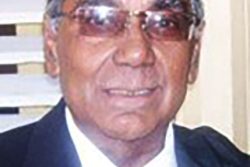 In the summer of 2011, I felt deeply honoured when I was asked to deliver the Inaugural Roy AK Heath Lecture at the Centre for Caribbean Studies, University of Warwick. The title of that lecture was ‘Aspects of Indian Culture in the Caribbean: The Impact of Theatrical Traditions, Cultural Change and the Popular Culture’.
In the summer of 2011, I felt deeply honoured when I was asked to deliver the Inaugural Roy AK Heath Lecture at the Centre for Caribbean Studies, University of Warwick. The title of that lecture was ‘Aspects of Indian Culture in the Caribbean: The Impact of Theatrical Traditions, Cultural Change and the Popular Culture’.
There were two reasons why that subject was considered fitting. The first was that it was also the keynote address of an international conference on Indo-Caribbean Culture and Literature, hosted by the university. The institution seemed to have thought, with good reason, that the two events – the Memorial Lecture and the Opening of the Conference – could profitably have been put together.
The second reason is that the conference organisers were not wrong. There is a reasonable degree of confluence between the work of major Guyanese novelist Roy Heath and Indo-Caribbean culture and literature. The prize winning novel, The Shadow Bride (1989) may be regarded as Heath’s magnum opus as a writer of fiction. Critic Ameena Gafoor ironically subtitled her study of this novel, “A Passage from India”. Gafoor’s intertextual reference was to EM Forster’s memorable work A Passage to India, but it focused on the heroine of Heath’s novel who came to Guyana from India as the wife of a Guyanese of Indian descent. Further, the work has been jokingly called “A House for Mrs Tulsi” by critic Jeffrey Robinson, but it quite seriously explores an epic study of that woman struggling with existence, identity and culture in her adopted home in a novel that quite rightly bears critical comparison to Naipaul’s preoccupations in A House for Mr Biswas.
Additionally, Heath himself in his acceptance speech when The Shadow Bride won the 1989 Guyana Prize for Literature spoke of it as a work of unique achievement because a black male author was able to explore the female psyche in a way not managed before. It is the close psychological study of a woman, but also of an Indian woman. He also found fulfilment in his representation of the ethos in both the middle class and the working class in the Guyanese East Indian community.
All of the foregoing finds thorough and insightful critical coverage in Ameena Gafoor’s full-length study of Roy Heath in Aftermath of Empire: The Novels of Roy AK Heath (UWI Press, 2017). It provides all relevant biographical information about Heath, paying attention to the claim that very little is known about his life between his departure from British Guiana for England in 1950 and the appearance of his first novel in 1974. Gafoor fills that gap with a certain degree of satisfaction, including material taken from his incomplete autobiography Shadows Round the Moon: Caribbean Memoirs (1990). She draws further from her interview with Heath in 1993. Gafoor also highlights the strange revelation that Heath claimed he deliberately left out his life in London because he did not wish to acknowledge England and British society; nor did he want to be labelled British-Guyanese like many other Caribbean writers in the UK.
Indeed, this fierce anti-colonial stance is studied by Gafoor and informs her investigation of Heath’s novels. Aftermath of Empire provides detailed analysis of all of his nine novels in addition to the autobiography. The very title of Gafoor’s study tells the tale of Heath’s quarrel with colonialism. Heath’s private life, as well as the Guyana he fictionalised in the novels were influenced by its colonial experience and Gafoor’s title looks at Heath’s Guyanese society, its fractured, lost, disturbed people and their often tragic existence in the after-effects of the reign of the British Empire. Heath blamed the empire for the plight of his people and for his own experiences in Britain.
Gafoor covers his personal life in “A Portrait of the Artist” (in deference to James Joyce’s A Portrait of the Artist as A Young Man – another of the intertextual references of which she seems fond). Heath was born in Georgetown in 1926, a city in which he grew up until his departure in 1950. His parents were members of the coloured middle class, but he lived among working class people both Black and Indian in the wards of the city. He worked in the civil service, was posted in a predominantly Indian community, and cultivated a few Indian friends. Heath attributed his familiarity with the Indian ethos to these experiences and even found models for characters he depicted in The Shadow Bride.
Additionally, he paid close attention to the people, particularly suffering humanity, that he encountered in neighbourhood communities as well as in his work. Gafoor is able to do a very useful analysis of the role this played in the construction of the novels. He was born and grew up in the city and his fiction was predominantly urban, as against the focus of some of his more eminent contemporaries like Jan Carew and Wilson Harris.
That the University of Warwick was willing to establish a lecture series in his memory is testimony to the recognition and importance paid to Heath as a notable West Indian writer. Gafoor stresses that he has received very little critical attention and his work is not very well known. Perhaps that is something Warwick sought to correct. Gafoor’s work therefore goes a very long way in adding to this recognition. But she herself makes reference to many other publications on Heath’s work, including one other full-length study which analyses seven of the novels. Gafoor provides a long list of critical articles.
Heath’s place in West Indian literature may be seen in the context of social realism as well as Guyanese post-Independence literature. Social realism in West Indian fiction started with HG de Lisser in Jamaica around 1913 when he (a privileged white middle class editor of The Gleaner newspaper) began serialising his novels in the newspaper. His focus in these works belied his social class, as was the case with CLR James in Trinidad who, from 1929, also developed social realism in his own country along with others such as Alfred Mendez. In British Guiana Edgar Mittelholzer was responsible for the rise of social realism when he published Corentyne Thunder in 1941. Jan Carew, Peter Kempadoo, Sheik Sadeek and Angus Richmond continued this development until Heath joined in the 1970s.
In Aftermath of Empire, Gafoor places Heath in this context alongside other Guyanese novelists and is able to be very enlightening in details about Mittelholzer, Harris, Kempadoo and Carew in particular. But Angus Richmond is to be added to this as a novelist who quite closely resembles Heath in career and preoccupations. She makes no reference to him.
Nevertheless readers are enriched by Gafoor’s detailed analysis of all Heath’s novels. There are chapters on From the Heat of the Day, One Generation, Genetha, A Man Come Home, The Murderer, Orealla, Kwaku, The Ministry of Hope, and The Shadow Bride.
(Ameena Gafoor is a Guyanese literary critic, editor, and cultural activist. She has published widely and is the editor of a foremost peer reviewed periodical, The Arts Journal, and funded “The Arts Forum”, which has been responsible for conferences on East Indian Studies, art exhibitions and other cultural activities. She has served as a member of the Jury for the Guyana Prize for Literature. Her most recent publication is A Lantern in the Wind: A Fictional Memoir, her autobiographical creative non-fiction about her own Muslim family history, released in 2020 by Hansib in the UK.
The importance of her work has received significant recognition through the recent establishment of The Amena Gafoor Foundation in the UK. This is a centre for research and seminars managed by Professor David Dabydeen, Fellow of the University of Cambridge, formerly of University of Warwick and Guyanese Ambassador to China, and to UNESCO.)
![The cover of Aftermath of Empire: The Novels of Roy AK Heath,[Ameena Gafoor, Aftermath of Empire: The Novels of Roy AK Heath, Kingston: University of the West Indies Press, 2017. 256 pp.]](https://s1.stabroeknews.com/images/2022/06/Aftermath.jpg)








